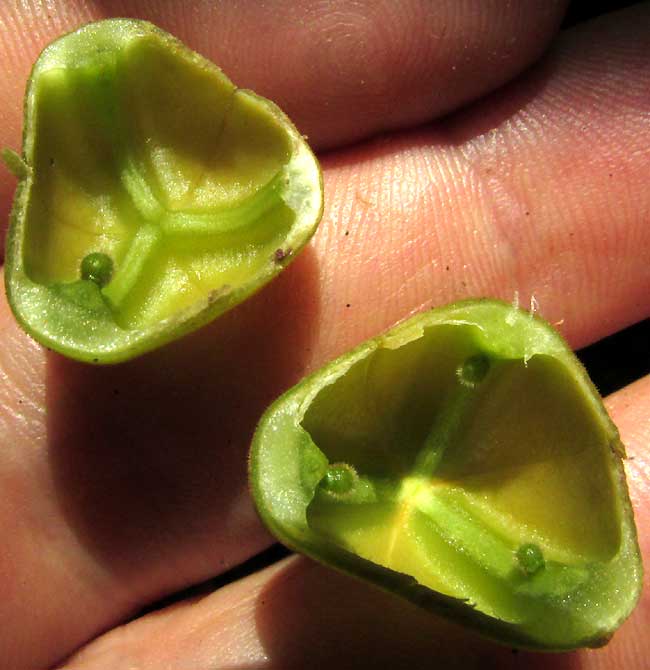Excerpts from Jim Conrad's
Naturalist Newsletter
from the March 15, 2019 Newsletter with notes from an October, 2018 camping trip to near the ruins of Palenque, Chiapas, southern MÉXICO; bedrock limestone, elevation ~80m (~260ft); N17.49°, W92.04°
GUATEMALAN RINOREA FRUITING
On October 4th, 2018, during my late-rainy-season camping trip into Chiapas, Mexico's southernmost state, in the deeply shaded understory of a hillside woods adjacent to Maya Bell Campground in Palenque National Park, a small tree caught my eye with its unusual arrangement of leaves and fruit, as shown below:

At first glance that looks like a pinnately compound leaf with a green fruit where its terminal leaflet should be, but the laws of leaf anatomy just don't permit such a thing. A closer look showed that what appear to be leaflets are actual leaves arising opposite one another on a slender stem, and a fruit has every right to be borne at a branch tip. In fact, nearby another tree bore a cluster of branch-tip fruits in a standard raceme, as shown below:

Normally I need flowers to identify new-to-me plants so,I figuring that this would be a hard one, having just fruits, I scanned the tree for more field marks. One that stood out, and which was valuable during identification, was the leaves' petioles, shown below:

First, they're covered with tiny, rusty-brown, wartlike things, a condition that one technical paper describes as "densely brownish hirtellous." Also, at the stem, the petioles start out round in cross section, but toward the blade develop a conspicuous channel. This was nice to notice, but the real breakthrough was when a fruit was cut open, revealing what's shown below:

The capsular fruit is one-celled -- not divided into compartments like many fruits -- with three placentae along the walls, each bearing one or two ovules, which are the future seeds.
Next to the hut up in the Yucatan the most commonly occurring bush produces much smaller fruits structured very similarly to these . The Yucatan bush is Hybanthus yucatanensis, a member of the Violet Family, even though northern botanists often have a hard time accepting that the Violet Family can produce woody species. You can compare our Chiapas fruit with that of Hybanthus yucatanensis at www.backyardnature.net/yucatan/hybanth.htm
Our Chiapas tree wasn't another species of Hybanthus, but rather a member of an even woodier genus. It was RINOREA GUATEMALENSIS, distributed from southeastern Mexico and Belize south to Honduras, so basically it's endemic to Guatemala and contiguous areas. Mature trees can reach 12m tall (40ft), which is pretty good for a family we usually think of as producing little violets and pansies. It's described as inhabiting the understory of mixed or wet tropical forests in lowlands and submountainous regions usually with a pronounced dry season, and that's exactly where we found it.
In the literature, not much is said about this species. It's just one of those species that when you're wandering in the wet, shadowy understory of a tropical forest and you see it, you're glad to find yet another interesting and attractive way of being, and a species that surely has its fascinating and useful aspects, if you just get to know it better.